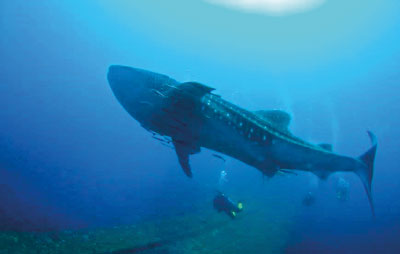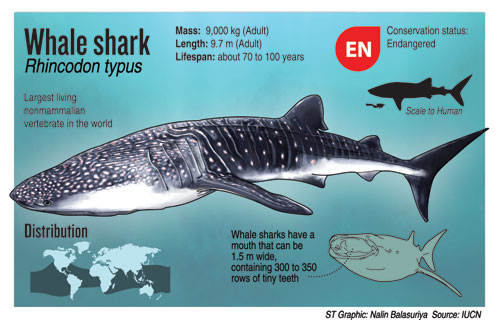News
Gentle marine giant drawn to our waters

A whale shark seen with a swimmer off Colombo. Pic courtesy Nishan Perera
As the sightings of whale sharks increase in our waters, experts say the world’s largest fish needs to be protected.
“We still know very little about whale sharks, but the fish is already ‘endangered’ and highly threatened by both target and bycatch fisheries,” says marine biologist from Blue Resources Trust, Daniel Fernando. He made the remarks at a lecture at an event organised by Sri Lanka Sub-Aqua Club this week.
The blue whale is the largest creature on Earth, but since it is a marine mammal, the crown of being the largest fish goes to the whale shark. A whale shark can grow up to 40 feet (12 meters) or more and weigh about 20 tons. The average whale shark is 8 metres long, but the ones found in Sri Lankan waters are 6-7 metres according to Mr Fernando.
Scientifically classified as rhincodon typus, the whale shark called ‘mini muthu mora’ in Sinhala is in fact a species of shark. But unlike other sharks, they do not have teeth and they are filter feeders that depend on plankton. By opening their huge gaping mouths closer to the surface, they scoop in these plants along with any small fish.
Divers have reported more sightings in the seas off Colombo.
Nishan Perera, a marine biologist who has made regular dives in the oceans off Colombo, reported more whale shark sightings in February and March when these fish are seen in our waters. “Two or three whale shark sightings during this period is normal, but this year there were dozens of encounters,” Mr Perera said.
The Maldives is a famous destination for whale sharks and queries revealed a lower number of encounters in Maldivian waters when there was an increase in our waters said Mr Perera. The whale sharks have spots on the body and its pattern is unique for each individual. So, the Sri Lankan marine biologists also shared the photos of the whale sharks seen in Sri Lankan waters with other international whale shark databases to verify where they are from.
It could be the same individuals seen in different occasions, but the fact that they are seen more often means that the fish that are used to passing through our waters are staying a little longer than previous years.
Author of the “Sharks of Sri Lanka”; Rex I De Silva says the large number of recent sightings baffle him. He says these fish usually migrate to areas rich in plankton. These areas are where there is an upwelling of nutrient-rich water from the depths. So, it is possible that, fuelled by changes in hydrologic factors, such upwellings are now occurring with greater frequency in our coastal waters. Upwellings encourage the growth of plankton which, in turn, attracts other plankton feeders such as fish. Whale sharks also feed on fish (especially small scombrids) which are attracted to the plankton.
Changing oceanic patterns due to global warming is another reason according to the expert. However, these are just suggestions as to why whale shark sightings have become common in recent years. We just do not have sufficient data to draw firm conclusions, cautioned Mr De Silva.
Howard Martenstyn, another expert, points out that there are more nutrients in the western seaboard compared to 2016 as evidenced by increased rainfall and river outflows and that may explain more whale shark sightings. Mr Matenstyn also reminds us that the number of sightings in the same area does not usually equate to the number of whale sharks, highlighting the need for more supporting data and investigations.
The whale shark is a gentle giant, which allows divers swim with them. They pose no danger to humans but an accidental blow from the powerful tail can cause injury. Experts advise keeping a minimum distance of 1.5 metres from the front of the body and 3 metres from the rear.
The whale shark takes about 15 years to mature to reproduce and is vulnerable to overfishing. Sri Lanka passed laws banning the catching of whale sharks in 2015, but awareness of such regulations, along with implementation, is often lacking points out Daniel Fernando.

| Sri Lanka shark slaughter continues Sharks have slow reproductive cycles and cannot be fished at levels similar to other fish. But sadly, Sri Lanka is among top 20 shark killing countries ranked at 14th place according to a 2013 report by the wildlife trade monitoring network TRAFFIC and the Pew Environment Group. The Fisheries Department says that steps have been taken to protect sharks. Five species are protected by law, including three species of thresher sharks, oceanic-white tip shark, and the whale shark. The department says it even distributes tools such as de-hookers and line cutters among fishermen that can be used to release sharks caught in nets or hooks. But more needs to be done to protect these apex predators in our ocean near the top of the marine food chain and help regulate populations of species in the marine ecosystem, the experts say. Sharks are also important to the economic survival of the fishing industry and have the potential to attract tourists. So Sri Lanka should follow the example of the Maldives and other nations to support international conservation and protection of sharks, marine expert Howard Martenstyn, says. Several species of shark migrate into different areas of oceans governed by different countries. So to protect them, the Convention of Migratory Species initiated a memorandum of understanding on the conservation of migratory sharks in 2010. Sri Lanka has not yet signed this, but marine experts say this would be a great step forward in recognising the value of sharks within our national and regional waters, points out Daniel Fernando. |

